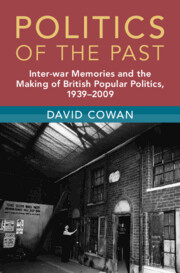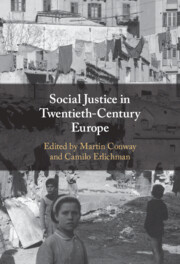258 results
2 - The Gramscian Right, or Turning Gramsci on His Head
-
- Book:
- World of the Right
- Print publication:
- 27 June 2024, pp 34-66
-
- Chapter
- Export citation
9 - Working with Heritage Languages in Linguistics Classes
-
- Book:
- Heritage Languages
- Print publication:
- 27 June 2024, pp 206-241
-
- Chapter
- Export citation
43 - “Flung out of space”
- from How to Recognize the Queer Past before (and during) the Advent of Medicalization
-
-
- Book:
- The Cambridge History of Queer American Literature
- Published online:
- 17 May 2024
- Print publication:
- 06 June 2024, pp 770-785
-
- Chapter
- Export citation
8 - Fiction in the Post–Lawrence v. Texas Era, or Inventing Heteronormative Queerness
- from The Sexuality of American History
-
-
- Book:
- The Cambridge History of Queer American Literature
- Published online:
- 17 May 2024
- Print publication:
- 06 June 2024, pp 158-172
-
- Chapter
- Export citation
Chapter 5 - Class
- from Part I - Life and Times
-
-
- Book:
- Goethe in Context
- Published online:
- 16 May 2024
- Print publication:
- 23 May 2024, pp 48-56
-
- Chapter
- Export citation
American Reconstruction and the Abolition of Second Slavery: On Pascoe’s Intersectional Critique of Kant’s Theory of Labour
-
- Journal:
- Kantian Review , First View
- Published online by Cambridge University Press:
- 06 May 2024, pp. 1-9
-
- Article
- Export citation
24 - Variation in Gesture: A Sociocultural Linguistic Perspective
- from Part V - Gestures in Relation to Interaction
-
-
- Book:
- The Cambridge Handbook of Gesture Studies
- Published online:
- 01 May 2024
- Print publication:
- 18 April 2024, pp 616-640
-
- Chapter
- Export citation
2 - The Metropolitan Inns
-
- Book:
- Brotherhood of Barristers
- Published online:
- 11 April 2024
- Print publication:
- 18 April 2024, pp 19-51
-
- Chapter
- Export citation
3 - Huddersfield
-
- Book:
- Politics of the Past
- Published online:
- 05 April 2024
- Print publication:
- 11 April 2024, pp 104-135
-
- Chapter
- Export citation

Politics of the Past
- Inter-war Memories and the Making of British Popular Politics, 1939–2009
-
- Published online:
- 05 April 2024
- Print publication:
- 11 April 2024
Chapter 3 - Actors
- from Part I - Theatre Makers
-
-
- Book:
- The Cambridge Companion to British Theatre since 1945
- Published online:
- 14 March 2024
- Print publication:
- 21 March 2024, pp 61-80
-
- Chapter
- Export citation

Social Justice in Twentieth-Century Europe
-
- Published online:
- 29 February 2024
- Print publication:
- 07 March 2024
6 - Regionalism the ‘Pacific Way’
-
- Book:
- Regional Politics in Oceania
- Published online:
- 15 February 2024
- Print publication:
- 22 February 2024, pp 142-171
-
- Chapter
- Export citation
9 - Refugees’ Vulnerability towards Precarious Work
-
-
- Book:
- Diversity and Precarious Work During Socio-Economic Upheaval
- Published online:
- 01 February 2024
- Print publication:
- 08 February 2024, pp 163-182
-
- Chapter
- Export citation
2 - The Politics of Class
- from Part I - Histories of the Present
-
-
- Book:
- The Cambridge Companion to Contemporary African American Literature
- Published online:
- 14 December 2023
- Print publication:
- 21 December 2023, pp 46-62
-
- Chapter
- Export citation
The “Shop Girl” and White Nationalism: White Working-class Women and Femininity in Johannesburg Department Stores, 1930s–1970s
-
- Journal:
- International Labor and Working-Class History / Volume 104 / Fall 2023
- Published online by Cambridge University Press:
- 18 December 2023, pp. 55-76
-
- Article
-
- You have access
- Open access
- HTML
- Export citation
Chapter 4 - When Ideology Wavers
-
- Book:
- Faulkner's Cartographies of Consciousness
- Published online:
- 02 November 2023
- Print publication:
- 16 November 2023, pp 109-144
-
- Chapter
- Export citation
Chapter 1 - Tact’s History
-
- Book:
- Alone with Others
- Published online:
- 26 October 2023
- Print publication:
- 09 November 2023, pp 16-36
-
- Chapter
- Export citation
Chapter 9 - Anthropomorphism
- from Part II - Contexts and Controversies
-
-
- Book:
- The Cambridge Companion to Literature and Animals
- Published online:
- 26 October 2023
- Print publication:
- 09 November 2023, pp 170-184
-
- Chapter
- Export citation
32 - Historiographies and Commemorative Practices
- from Part III - Intersections: National(ist) Synergies and Tensions with Other Social, Economic, Political, and Cultural Categories, Identities, and Practices
-
-
- Book:
- The Cambridge History of Nationhood and Nationalism
- Published online:
- 08 November 2023
- Print publication:
- 09 November 2023, pp 682-705
-
- Chapter
- Export citation



